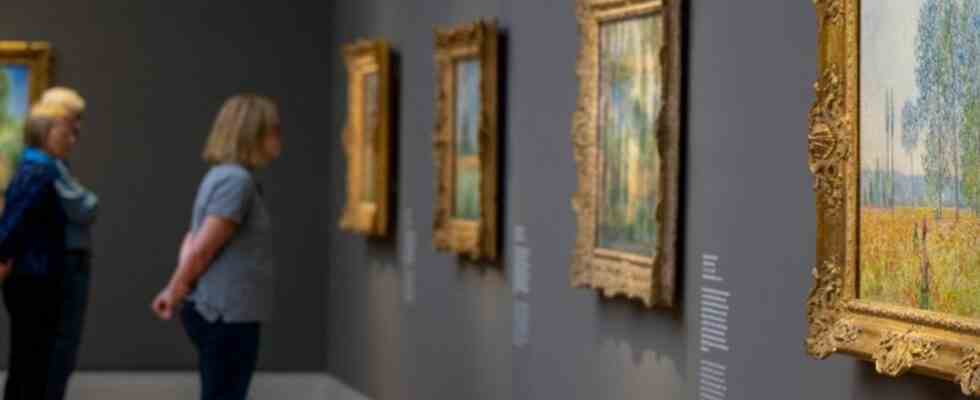art
Museum Barberini reopened after attack
Paintings in the Impressionist exhibition at the reopened Museum Barberini. photo
© Monika Skolimowska/dpa
The attack on a Monet painting triggered a broad debate about the protection of art. The Museum Barberini has now reopened – after a forced break, so to speak. Then it hit other museums.
More and more disruptive actions and attacks on valuable images startle the art world. In the Barberini Museum in Potsdam’s city center crowds of visitors were again able to look at Monet’s “Getreidestack” from 1890 on Monday.
Just over a week ago, climate activists threw mashed potatoes at the painting, which costs more than 100 million euros, but nothing happened to the work of art behind glass. It can again impress with its “bright colourfulness”, as the description on the wall says.
The Barberini closed after the attack to discuss increased security. At the weekend there were new disruptive maneuvers in Berlin museums, which triggered a lack of understanding in politics.
Great interest in the Surrealists
In Potsdam, museum director Ortrud Westheider observed the great interest of visitors at the reopening on Monday. “It’s a particularly beautiful moment,” she said. The visitors were not only attracted by the art of the Impressionists, but also booked guided tours through the new Surrealism exhibition with works by Salvador Dalí, Max Ernst or René Magritte. One visitor said he wasn’t just here because of the one Monet. Numerous tourists were already queuing in front of the classicist-baroque building before it opened.
But first, according to the new safety regulations, all bags and jackets had to be put in the lockers and in the cloakroom. According to the director, there are also more security personnel. More protection was discussed behind the scenes in particular, and the steps should not be made public. In coordination with colleagues in London and Amsterdam, for example, a whole bundle of measures was created, said Westheider.
After the attack in the Barberini, a crowd puller since it opened in 2017, there was great uncertainty. “This event comes as a shock to us. We have to explain the fragility of irreplaceable works of art and thus counteract the trivialization of such incidents,” said Westheider. The museum quickly exchanged ideas with the lenders of the paintings. “Fortunately none of the works were reclaimed.”
The climate activists use the power of images
But there remains a risk that museums will continue to be targeted by activists. At the weekend, two women glued themselves to the handrails of a dinosaur skeleton in the Berlin Museum of Natural History. In the Old National Gallery, an action triggered a police operation: the glass-enclosed painting “Clown” by Henri de Toulouse-Lautrec was pelted with artificial blood. Climate activists should have nothing to do with it (unlike with the action in the Museum of Natural History).
The action group “Last Generation” primarily wants to attract attention with their disruptive maneuvers and is outraged that, as they say, a work of art is more important than the destruction of the planet. To do this, they use the power of classic images – and produce new ones with great attention. “We have to think about actions that cannot be ignored,” said Jakob Beyer, who belongs to the group, to the ARD culture magazine “ttt – titel, thesen, temperamente”.
Minister of State for Culture Claudia Roth doubts that attacks on irreplaceable works of art will really bring more attention to the fight against climate change. “If the actions continue in this form, it is only a matter of time before a work of art is actually irretrievably damaged,” it said in its statement. The founder of the Museum Barberini, the art patron Hasso Plattner, who owns the large Impressionist collection, sees a risk that exhibitions with loans will be more difficult in the future.
But could the attack on the valuable Monet, famous for his flair for landscapes, also stimulate a debate about climate protection? The early environmental protection movement began in this period of the 19th century, and Impressionist painting already addressed environmental pollution, for example when Monet painted the smog of London or also showed a steel mill, Westheider said. “The Impressionists do not show innocent landscapes.” It should be discussed to what extent impressionistic images can also be sources for climate research. “We’ve been in talks with climate researchers and art historians from Philadelphia to Potsdam for some time.” Events, perhaps exhibitions, could develop from this, the director announced.
Despite the adhesive campaign by climate activists, the Berlin Museum of Natural History would like to continue to promote an open exchange. “We offer a lot of dialogue. We have worked with Fridays for Future for years. The law and the law set limits. For any action,” said the museum’s director general, Johannes Vogel, on Monday of the German Press Agency. Despite the incident in his house, there should not be any stricter security checks.

